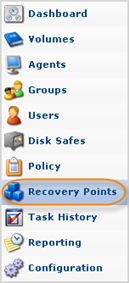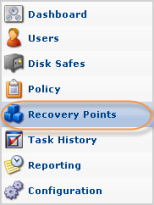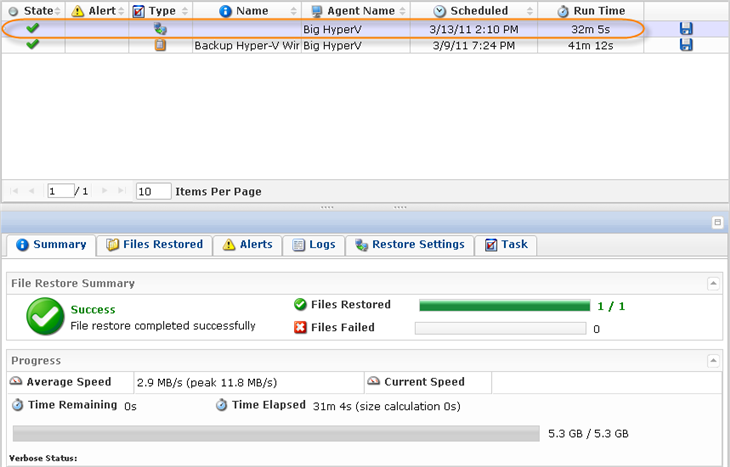You can restore VHD files using CDP. Follow the instructions below.
1. Click on "Recovery Points" in the Main Menu to open the "Recovery Points" window.
| Standard Edition | Enterprise Edition | Advanced Edition |
|---|---|---|
 |
 |
 |
2. Enterprise Edition: In the "Recovery Points" list, select an Agent from the drop-down menu located on the "Recovery Points" list toolbar.

3. From the drop-down menu located on the "Recovery Points" list toolbar, select a Disk Safe where the replication of VHD file is located.

4. Find a Recovery Point to restore from. Click on the "Browse" icon in the "Actions" column for this Recovery Point.

| Tip To find a Recovery Point, you can use the Basic and Advanced List Filters. See Customizing the Recovery Points List. |
5. The "Browse Recovery Point" window opens.
See also: Browsing Recovery Points.
6. Select the checkboxes next to the files and folders you want to restore.

7. Once the files and folders are selected, click on "Restore Selected."

8. The "Restore Files" window will open.
9. Specify the following options:
Restore to Agent
- Agent - Select this option to restore to an Agent already added to the system. Connects to the Agent name and uses the port configured.
- Host Name/IP - Connect to the specified hostname and port. This option allows you to Restore to a Host with a Host Name/IP address different than the original Host.
- Port Number
Restore to Folder
- Original Location - Restores to the same directories when the Recovery Point was created.
- Alternate Location - Specify a path on the Host to Restore the files to. The complete path and directory structure of all selected files will be created under the path specified here. If the specified path does not exist, it will be created.
- Overwrite Existing Files - When enabled, any existing files or directories with the same name will be overwritten, even if they are newer.
Advanced Options
- Estimate Restore Size - Enabled by default. When enabled you can see the additional "Estimated Restore Size" and "Estimated Object Count" values in the "Reporting" page - "Summary" tab - "Restore Status" area.
- Restore Discretionary ACLs (File Permissions)
- Restore System ACLs (Audit Rules)
In our example we select an existing Agent "Big HyperV" and the "Original Location" option.

10. Click on "Restore."

11. A notification window will inform you that the Restore task has been scheduled. It means the Task has started. The "Reporting" screen displays the progress of the Task.
Click "OK" in the displayed window.

| Tip The Task results can be sent via Email as a Report. See Reporting. |
12. To view the Restore Task details, access the "Reporting" window. See Accessing Task History.

13. After you have restored the VHD file, in order to access its contents you need to attach and mount it using the Hyper-V VHD Explorer. See Attaching VHDs, Mounting VHD Volumes.
